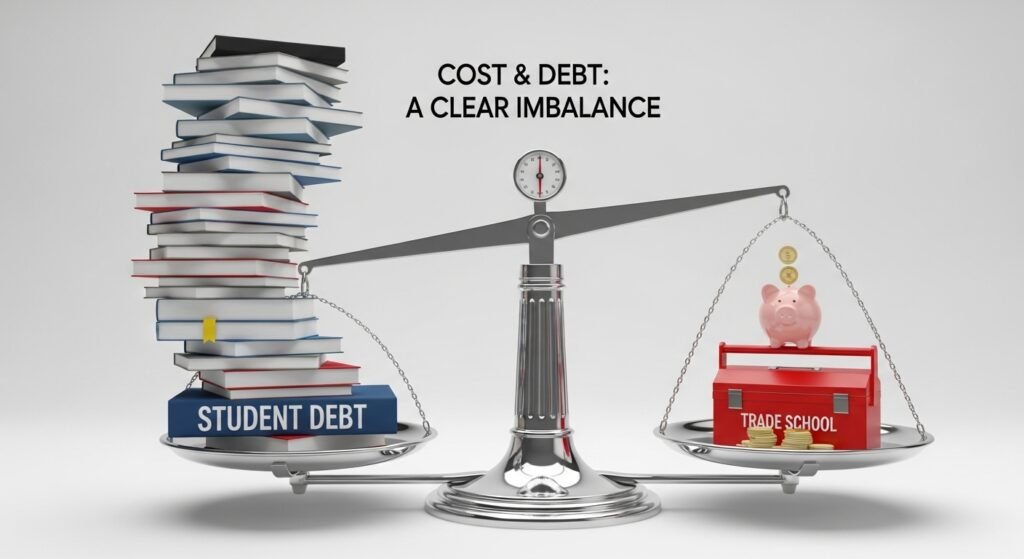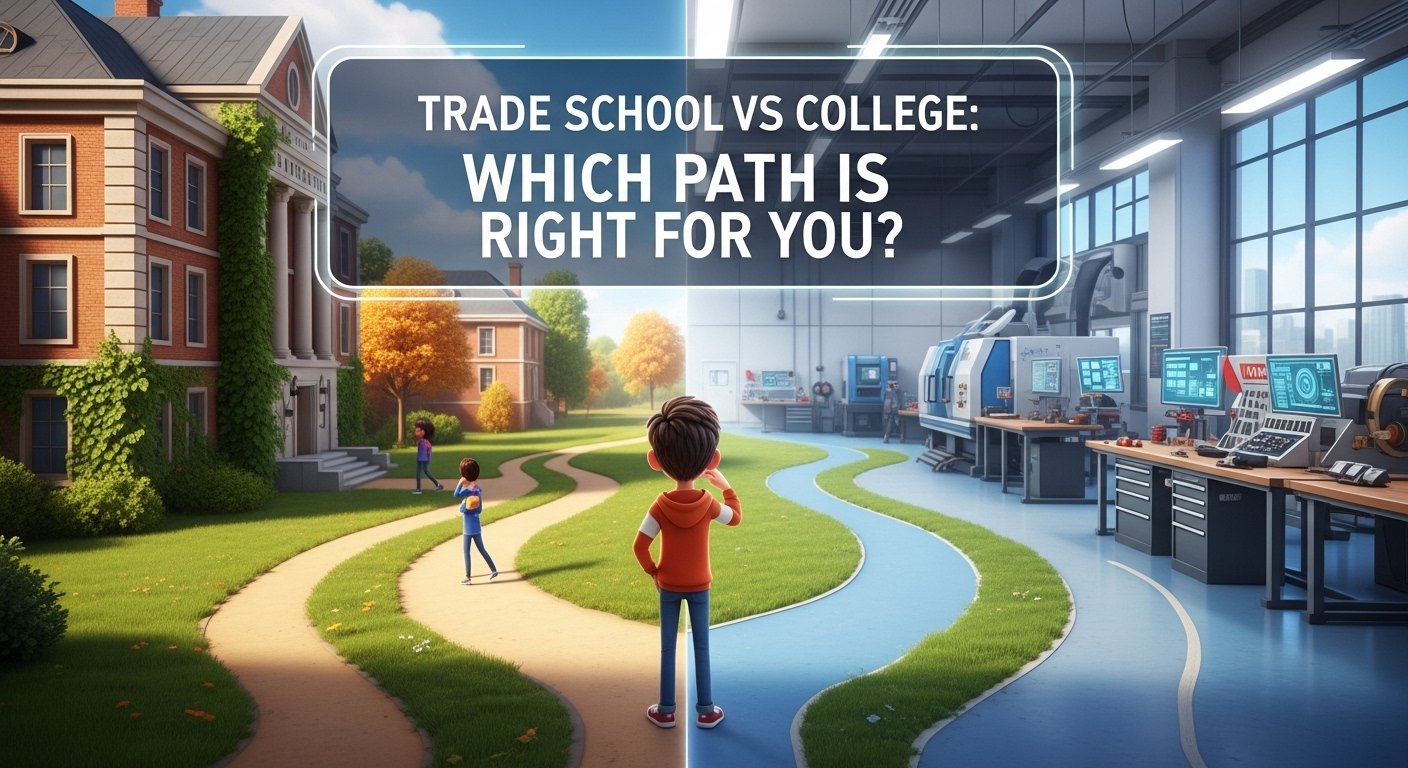For generations, we’ve been told a very specific story about success. It goes something like this: study hard in high school, get into the best four-year university you can, graduate with a degree, and then—and only then—can you start your career. It’s a script that has been drilled into students and parents for decades.
But what if that script is outdated?
As an educator and a tech enthusiast, I’ve seen firsthand how the world of work is changing at lightning speed. The relentless rise of student loan debt, coupled with a booming demand for skilled professionals, is forcing us to ask a critical question: Is the traditional university path the only road to a successful, high-paying career?
The short answer is a resounding no. An entirely different, powerful, and often faster path exists—the world of trade schools and vocational careers. So today, let’s set aside the old script. Let me break down the real data in the great trade school vs college debate and give you a practical framework to decide which path is truly the best fit for you.
What Exactly Are We Comparing? The 4-Year University vs. The Trade School
Before we dive into a head-to-head comparison, it’s crucial to understand that these two educational models are designed for fundamentally different goals. It’s not about which one is “smarter”; it’s about which one is the right tool for the job you want.
The University Experience: In-Depth Knowledge and Broad Horizons 🎓
A traditional four-year university is designed to give you a broad, theoretical education. You’ll spend the first couple of years exploring a wide range of subjects—history, science, literature, philosophy—before diving deep into your chosen major.
- The Goal: To develop critical thinking, complex problem-solving, and strong research and writing skills.
- The Analogy: A university teaches you why a car engine works. You’ll learn the physics of combustion, the history of the automobile, and the economic principles of the auto industry. You’ll graduate with a deep, holistic understanding.

The Trade School Model: Specialized Skills for a Specific Career 🔧
A trade school (also known as a vocational or technical college) scraps the broad theoretical approach for a laser-focused, hands-on one. From day one, you are training for a specific job. Whether you’re learning to be a welder, a dental hygienist, an electrician, or a network technician, the curriculum is 100% dedicated to giving you the practical skills needed to get hired.
- The Goal: To achieve mastery in a specific, in-demand skill and enter the workforce as quickly as possible.
- The Analogy: A trade school teaches you how to fix the car engine. You’ll spend your time in a workshop, taking engines apart and putting them back together. You’ll graduate knowing how to diagnose and solve real-world problems.
Trade School vs College: The Ultimate Head-to-Head Breakdown
Now for the main event. Let’s put these two paths side-by-side and compare them on the factors that matter most to students and their families.
[Suggestion: Insert a detailed comparison table here with rows for Time, Cost, Debt, Learning Style, and Job Prospects.]
Factor 1: The Time Investment ⏰
This is one of the most dramatic differences.
- University: A bachelor’s degree is designed to take four years, but data shows many students take five or even six years to graduate.
- Trade School: Certificate or diploma programs are significantly shorter. They can range from as little as six months to two years.
- The Key Takeaway: A trade school graduate can be in the workforce, earning a full-time salary and gaining valuable experience, while their university-bound peers are still in the classroom. That’s a 2-3 year head start in their career.
Factor 2: The Financial Equation (Cost & Debt) 💰
Here’s where the conversation gets really serious. The cost of higher education is a crisis in the United States and many other parts of the world.
- University: The average cost for a four-year degree can be staggering. When you factor in tuition, housing, and fees, the total cost can easily range from $100,000 to over $250,000, leading to significant student loan debt that can linger for decades.
- Trade School: The costs are a fraction of that. The total tuition for an entire trade school program often falls between $5,000 and $20,000. Furthermore, many trades have paid apprenticeship programs where you literally earn money while you learn.
- The Key Takeaway: Trade school students often graduate with little to no debt, putting them in a much stronger financial position at the start of their careers.

Factor 3: The Learning Style 🧠
How do you learn best? This is a question not enough students ask themselves.
- University: The learning is primarily classroom-based and theoretical. It involves lectures, reading dense textbooks, writing research papers, and taking exams. This is perfect for those who love academic inquiry and abstract concepts.
- Trade School: The learning is hands-on and practical. You’ll spend most of your time in a workshop, a lab, or a real-world clinical setting, using the actual tools of your trade. This is ideal for kinesthetic learners who learn by doing.

Factor 4: Job Prospects & Earning Potential 💼
This is where we need to bust some major myths. The assumption that a university degree automatically leads to a higher salary is no longer a guarantee.
- University: Graduates in high-demand fields like engineering, computer science, and finance often command high starting salaries. However, graduates in other fields may face a competitive job market where their degree doesn’t lead directly to a specific job.
- Trade School: Graduates are often in extremely high demand because they have skills that are essential to the economy. Many skilled trades offer incredible earning potential. According to the U.S. Bureau of Labor Statistics, the median pay for many of these jobs is impressive [External Link to the Bureau of Labor Statistics Occupational Outlook Handbook]:
- Electrician: ~$60,000/year
- Plumber: ~$59,000/year
- Aircraft Mechanic: ~$65,000/year
- Dental Hygienist: ~$77,000/year
- Welder: Can earn well over $60,000 with experience and specialization.
The key here is certainty. Trade school graduates enter a market with clear demand for their specific skill set.
So, How Do You Choose? A Practical Self-Assessment
There is no single “best” answer in the trade school vs college debate. The best path is the one that aligns with your personality, goals, and learning style.
Here’s a practical tip: ask yourself these questions honestly.
- How do I learn best? Am I energized by classroom debates and research papers, or do I prefer to get my hands dirty and build something?
- What is my financial situation? Am I comfortable with the idea of taking on significant student loan debt, or is graduating debt-free a major priority?
- How quickly do I want to start my career? Am I excited about a four-year campus experience, or do I feel an urgent need to start working and earning money?
- What does my ideal workday look like? Do I see myself in an office, a lab, or a classroom? Or do I see myself on a construction site, in a high-tech manufacturing plant, or a medical clinic?
Your answers to these questions will point you in the right direction.
Frequently Asked Questions (FAQ)
Yes, absolutely! Many students get a trade school certificate, work in their field for a few years, and then go on to get a bachelor’s degree in a related field, like construction management or business. Many universities offer credit for trade school experience.
Beyond the classics like electricians and welders, many tech and healthcare-focused trades are booming. Look into careers like respiratory therapist, web developer, HVAC technician, diagnostic medical sonographer, and aircraft mechanic.
Yes. Accredited trade and vocational schools are eligible for federal financial aid, including grants and student loans, just like traditional universities. You can fill out the FAFSA (Free Application for Federal Student Aid) to see what you qualify for.
Look for schools that are accredited by a recognized agency. This is crucial for financial aid and for ensuring the quality of your education. Read reviews, talk to former students, and most importantly, check their job placement rates. A good school will be proud to tell you what percentage of their graduates get jobs in their field.

There is No “Best” Path—Only the Best Path for You
The key takeaway here is that the old script is finished. A four-year university degree is a fantastic and valuable path for many, but it is not the only path. A trade school education is an equally valid, respectable, and often more direct route to a stable, high-paying, and fulfilling career.
The most important thing you can do is to give yourself permission to explore all your options without judgment. Research the careers, talk to people in the fields that interest you, and make an informed decision based on your own unique talents and aspirations.
Which path feels more aligned with your goals? Have you considered a trade school career? Share your thoughts and questions in the comments below!



